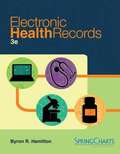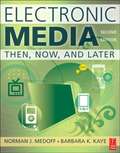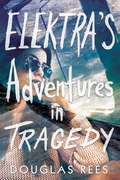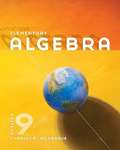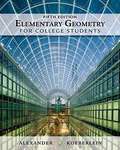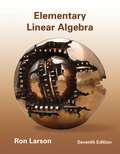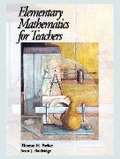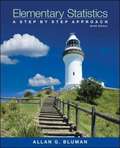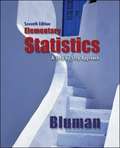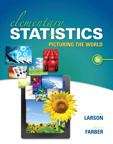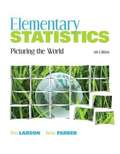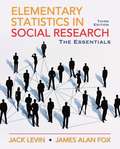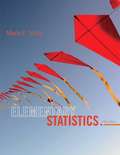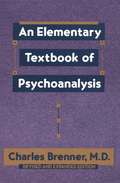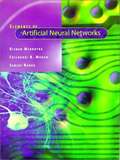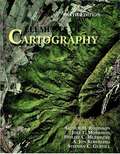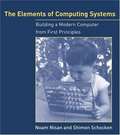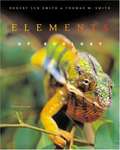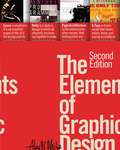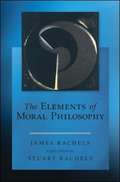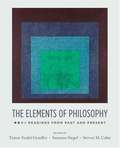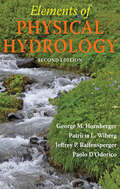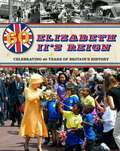- Table View
- List View
Electronic Health Records (Third Edition)
by Byron Hamilton Leesa HamiltonHamilton, Electronic Health Records, 3e is the top choice for training students using live and up-to-date SpringCharts EHR software. Electronic Health Records 3e builds transferable medical documentation skills with a variety of exercises that walk students through different facets of using an EHR in the medical office. As students progress through SpringCharts, they learn to gather patient information, schedule appointments, record examination information, process lab tests, select codes, and more. Students who complete this course will learn the appropriate terminology and skills to use any EHR software program with minimal additional training. The practical, systematic approach is based on real-world medical office activities.
Electronic Media: Then, Now, And Later (Second Edition)
by Norman Medoff Barbara K. KayeElectronic Media connects the traditional world of broadcasting with the contemporary universe of digital electronic media. It provides a synopsis of the beginnings of electronic media in broadcasting, and the subsequent advancements into digital media. Underlying the structure of the book is a "See It Then, See It Now, See It Later" approach that focuses on how past innovations lay the groundwork for changing trends in technology, providing the opportunity and demand for change in both broadcasting and digital media. FYI and Zoom-In boxes point to further information, tying together the immediate and long-ranging issues surrounding electronic media. Career Tracks feature the experiences of industry experts and share tips in how to approach this challenging industry.
The Elegant Essay (Third Edition)
by Lesha MyersThis student book vividly portrays the art of writing elegant essay. The Appendix includes Teaching Models, Grading Sheets, and IEW Essay Model & Style Techniques.
Elektra's Adventures in Tragedy
by Douglas ReesFunny and smart with all the angst and sass of adolescence and a colorful cast of characters, this is a refreshing contemporary coming-of-age YA about one Greek-American girl's odyssey home. Sixteen-year-old Elektra Kamenides is well on her way to becoming a proper southern belle in the small Mississippi college town she calls home. That is, until her mother decides to uproot her and her kid sister Thalia and start over in California. They leave behind Elektra's father--a professor and leading expert on Greek mythology, and Elektra can't understand why. For her, life is tragedy, and all signs point to her family being cursed. Their journey ends in Guadalupe Slough, a community of old Chicano families and oddball drifters sandwiched between San José and the southern shores of San Francisco Bay. The houseboat that her mother has bought, sight unseen, is really just an ancient trailer parked on a barge and sunk into a mudflat. What would Odysseus do? Elektra asks herself. Determined to get back to Mississippi at all costs, she'll beg, lie, and steal to get there. But things are not always what they seem, and home is wherever you decide to make it.
Elementary Algebra (Ninth Edition)
by Charles P. MckeagueThe book intends to improve the ability of college students, while getting them ready to make a successful start in intermediate algebra.
Elementary Geometry for College Students
by Daniel C. Alexander Geralyn M. KoeberleinBuilding on the success of its first four editions, the Fifth Edition of this market-leading text covers the important principles and real-world applications of plane geometry, with a new chapter on locus and concurrence and by adding 150-200 new problems including 90 designed to be more rigorous. Strongly influenced by both NCTM and AMATYC standards, the text takes an inductive approach that includes integrated activities and tools to promote hands-on application and discovery.
Elementary Linear Algebra
by Ron LarsonThe cornerstone of ELEMENTARY LINEAR ALGEBRA is the authors' clear, careful, and concise presentation of material--written so that readers can fully understand how mathematics works. This program balances theory with examples, applications, and geometric intuition for a complete, step-by-step learning system. Featuring a new design that highlights the relevance of the mathematics and improves readability, the Seventh Edition also incorporates new conceptual Capstone exercises that reinforce multiple concepts in each section. Data and applications reflect current statistics and examples to engage users and demonstrate the link between theory and practice.
Elementary Mathematics for Teachers
by Thomas H. Parker Scott J. BaldridgeA mathematics course for elementary teachers.
Elementary Statistics: A Step By Step Approach (Ninth Edition)
by Allan G. BlumanElementary Statistics: A Step By Step Approach is for introductory statistics courses with a basic algebra prerequisite. The text follows a nontheoretical approach, explaining concepts intuitively and supporting them with abundant examples. In recent editions, Al Bluman has placed more emphasis on conceptual understanding and understanding results. Additionally step-by step instructions on how to utilize the TI-84 Plus graphing calculator, Excel, and Minitab, have also been updated to reflect the most recent editions of each technology.
Elementary Statistics: A Step by Step Approach
by Allan G. BlumanELEMENTARY STATISTICS: A STEP BY STEP APPROACH is for general beginning statistics courses with a basic algebra prerequisite. The book is non-theoretical, explaining concepts intuitively and teaching problem solving through worked examples and step-by-step instructions.
Elementary Statistics: Picturing the World, 6th Edition
by Ron Larson Betsy FarberElementary Statistics: Picturing the World, Sixth Edition, provides stepped out instruction, real-life examples and exercises, and the use of technology to offer the most accessible approach. The authors carefully develop theory through strong pedagogy, and examples show how statistics is used to picture and describe the world. In keeping with the premise that students learn best by doing, it includes more than 210 examples and more than 2300 exercises, to make the concepts of statistics a part of students' everyday lives.
Elementary Statistics: Picturing the World (Fifth Edition)
by Ron Larson Betsy FarberThis textbook is written with a balance of rigor and simplicity. It combines step-by-step instruction, real-life examples and exercises, carefully developed features, and technology that makes statistics accessible to all. The Fifth Edition has a thorough update of the key features, examples, and exercises.
Elementary Statistics in Social Research: The Essentials
by James Fox Jack LevinThis text provides a streamlined and accessible introduction to statistics for students in sociology, criminal justice, political science, social work, and other social sciences. This text offers an essential and accessible overview to the introduction to social statistics. Clearly written with detailed step-by-step illustrations of statistical procedures, this text provides clear and logical explanations for the rationale and use of statistical methods of social research. Numerous end-of-chapter questions in every chapter reinforce key concepts to students.
Elementary Statistics (Twelfth Edition)
by Mario F. TriolaFrom SAT scores to job search methods, statistics influences and shapes the world around us. Marty Triola's text continues to be the bestseller because it helps students understand the relationship between statistics and the world, bringing life to the theory and methods. Elementary Statistics raises the bar with every edition by incorporating an unprecedented amount of real and interesting data that will help instructors connect with students today, and help them connect statistics to their daily lives. The Twelfth Edition contains more than 1,800 exercises, 89% of which use real data and 85% of which are new. Hundreds of examples are included, 91% of which use real data and 84% of which are new. New coverage of Ethics in Statistics highlights new guidelines that have been established in industry.
The Elements of Alternate Style: Essays on Writing and Revision
by Wendy BishopElements of Alternate Style contributes to a better understanding of the writing process in general and the stylistic options available to every serious writer. It demonstrates how by teaching alternate and traditional styles in tandem, by focusing on revision as invention, we can help students become newly engaged with their texts-even "school writing. " In this edited collection, successful classroom instructors explore and apply these ideas, drawing from composition pedagogy, creative writing technique, and critical theory. The six essays in Part I delineate an initial classroom sequence. . The authors ask writers to try writing exercises and to reconsider how they have constructed essays in the past-how they might reconstruct them today by looking and looking again, by fracturing and creating double voices, by reconsidering the place of research. Part II pushes these explorations further in five essays that contend that writing is about taking risks, trying (sometimes failing), learning from exploration, from play, from radical twists and turns. Part III engages even broader issues of identity, technology, correctness, and editing. Elements of Alternate Style is a powerful, liberating resource that validates innovative writing instruction and offers a rich array of voices and techniques.
Elements of Artificial Neural Networks
by Kishan Mehrotra Chilukuri K. Mohan Sanjay RankaElements of Artificial Neural Networks provides a clearly organized general introduction, focusing on a broad range of algorithms, for students and others who want to use neural networks rather than simply study them. The authors, who have been developing and team teaching the material in a one-semester course over the past six years, describe most of the basic neural network models (with several detailed solved examples) and discuss the rationale and advantages of the models, as well as their limitations. The approach is practical and open-minded and requires very little mathematical or technical background. Written from a computer science and statistics point of view, the text stresses links to contiguous fields and can easily serve as a first course for students in economics and management. The opening chapter sets the stage, presenting the basic concepts in a clear and objective way and tackling important--yet rarely addressed--questions related to the use of neural networks in practical situations. Subsequent chapters on supervised learning (single layer and multilayer networks), unsupervised learning, and associative models are structured around classes of problems to which networks can be applied. Applications are discussed along with the algorithms. A separate chapter takes up optimization methods. The most frequently used algorithms, such as back propagation, are introduced early on, right after perceptrons, so that these can form the basis for initiating course projects. Algorithms published as late as 1995 are also included. All of the algorithms are presented using block-structured pseudo-code, and exercises are provided throughout. Software implementing many commonly used neural network algorithms is available at the book's website. Transparency masters, including abbreviated text and figures for the entire book, are available for instructors using the text.
Elements Of Cartography
by Arthur H. Robinson Joel L. Morrison Phillip C. Muehrcke A Jon. Kimerling Stephen C. Guptill A. Jon KimerlingElements of Cartography, 6e continues its reputation as the market leader by integrating the latest in modern technology with traditional cartographic principles.
The Elements of Computing Systems: Building a Modern Computer from First Principles
by Noam Nisan Shimon SchockenIn the early days of computer science, the interactions of hardware, software, compilers, and operating system were simple enough to allow students to see an overall picture of how computers worked. With the increasing complexity of computer technology and the resulting specialization of knowledge, such clarity is often lost. Unlike other texts that cover only one aspect of the field, The Elements of Computing Systems gives students an integrated and rigorous picture of applied computer science, as its comes to play in the construction of a simple yet powerful computer system. Indeed, the best way to understand how computers work is to build one from scratch, and this textbook leads students through twelve chapters and projects that gradually build a basic hardware platform and a modern software hierarchy from the ground up. In the process, the students gain hands-on knowledge of hardware architecture, operating systems, programming languages, compilers, data structures, algorithms, and software engineering. Using this constructive approach, the book exposes a significant body of computer science knowledge and demonstrates how theoretical and applied techniques taught in other courses fit into the overall picture. Designed to support one- or two-semester courses, the book is based on an abstraction-implementation paradigm; each chapter presents a key hardware or software abstraction, a proposed implementation that makes it concrete, and an actual project. The emerging computer system can be built by following the chapters, although this is only one option, since the projects are self-contained and can be done or skipped in any order. All the computer science knowledge necessary for completing the projects is embedded in the book, the only pre-requisite being a programming experience. The book's web site provides all tools and materials necessary to build all the hardware and software systems described in the text, including two hundred test programs for the twelve projects. The projects and systems can be modified to meet various teaching needs, and all the supplied software is open-source.
Elements of Ecology 5th Edition
by Robert Leo Smith Thomas M. SmithWith a modular organization and a beautiful four color art program, the fourth edition of this leading text for non-majors continues to provide a clear presentation of the principles of ecology and illustrate their relation to today's environmental issues. Far-reaching in its coverage, the fourth edition provides the most up-to-date information with a new chapter on global warming and deforestation. It also focuses on ecology as a science, providing the basic background information needed to show the relevance of studying environmental problems on a global scale.
The Elements of Graphic Design: Space, Unity, Page Architecture, and Type (2nd Edition)
by Alex W. WhiteThis pioneering work has been wholly revised and expanded to feature a new dimension of inspiring and counter-intuitive ideas to thinking about graphic design relationships and provides designers, art directors, and students--regardless of experience--with a unique approach to successful design. The second edition includes a new section on Web design; new discussions of modularity, framing, motion and time, rules of randomness, and numerous quotes supported by images and biographies.
The Elements of Moral Philosophy 8th Edition
by James Rachels Stuart RachelsThe Elements of Moral Philosophy by James Rachels and Stuart Rachels is a best-selling text for undergraduate courses in ethics. Thirteen thought-provoking chapters introduce readers to major moral concepts and theories in philosophy through clear, understandable explanations and compelling discussions.
The Elements of Philosophy: Readings from Past and Present
by Susanna Siegel Steven M. Cahn Tamar Szabó GendlerThe Elements of Philosophy: Readings from Past and Present offers an extensive collection of classic and contemporary readings, organized topically into five main sections: Religion and Belief, Moral and Political Philosophy, Metaphysics and Epistemology, Philosophy of Mind and Language, and Life and Death. Within these broad areas, readings are arranged in clusters that address both traditional issues--such as the existence of God, justice and the state, knowledge and skepticism, and free will--and contemporary topics--including God and science, just war theory, vegetarianism, and time travel. Carefully chosen selections from a wide range of pre-20th-century philosophers are paired with writings from more than fifty leading contemporary philosophers and thinkers. The traditional philosophers represented range from Plato and Aristotle to Immanuel Kant and A. J. Ayer; the contemporary philosophers include Saul Kripke, David Lewis, Thomas Nagel, Derek Parfit, Hilary Putnam, Robert Nozick, Judith Jarvis Thomson, John Rawls, Bernard Williams, and Susan Wolf. Also included are selections from linguist Noam Chomsky, physicist Albert Einstein, and psychologist William James. Edited by a team of scholars who are also highly esteemed instructors, The Elements of Philosophy is uniquely student-friendly. A team of undergraduate philosophy majors played a central role in helping to select topics, choose readings, and identify terms likely to require clarification. In response to their suggestions, the volume includes detailed introductions to each section, explanatory footnotes that define unfamiliar terms and concepts, an extensive glossary, and a guide to further resources. A companion Instructor's Manual, available on CD, offers article summaries, suggested essay questions, reading guides, model handouts, and sample syllabi. One of the most extensive and expansive anthologies available, The Elements of Philosophy is an ideal choice for both general and targeted introductory philosophy courses.
Elements of Physical Hydrology
by George M. Hornberger Patricia L. Wiberg Jeffrey P. Raffensperger Paolo D'OdoricoThe most cogent textbook ever produced on the topic, this revised and expanded edition will be welcomed by students and professionals alike.Among the many diverse aspects of environmental science, none is more critical to the future of society and nature than water. Understanding the role of water on Earth and making good decisions regarding water conservation and hydrological hazards depends on learning the fundamentals of physical hydrology. This textbook, now in an expanded second edition, provides the clearest opportunity for students to absorb those fundamentals. Written at an introductory level, Elements of Physical Hydrology covers virtually every aspect of this subject, including:• The hydrological cycle• Water budgets at catchment to global scales • Spatial and temporal aspects of precipitation• Evapotranspiration• Fluid dynamics and the Bernoulli equation• Laminar and turbulent flows• Open channel flow • Flood movement through reservoirs and channels • Flood frequency analysis• Groundwater flow• Aquifer characterization• Land subsidence• Soil moisture dynamics• Flow in the unsaturated zone• Hydrologic controls on vegetation • Biotic controls on hydrological processes• Runoff generation from surface and subsurface sources• Catchment models• The water-food-energy nexus• The globalization of water• Impacts of changing climateLayering one topic upon the next, Elements of Physical Hydrology succeeds in moving from simple, easy-to-grasp explanations through equations and models in a manner that will leave students new to the topic eager to apply their knowledge. Professionals in related disciplines will also find this book ideal for self-study. Thoughtfully illustrated, carefully written, and covering a broad spectrum of topics, this classic text clarifies a subject that is often misunderstood and oversimplified.
Elizabeth II's Reign - Celebrating 60 years of Britain's History
by Jacqui BaileyElizabeth II's Reign examines the recent history of Britain. Exploring the Britain the Queen was born into and took over when her reign began, the Commonwealth, changing social times / family, fashion, technology and work the book builds up a picture of how life in Britain has changed.The book is bought alive with humourous cartoon and by memories in the form of quotes from people who remember the events and changes from the past 60 years. It is illustrated with pictures of the Queen and the Royal family and historical photos of life in Britain.With panels of facts about the Queen and the Royal Family, this is a great read for children and young adults in the year of the Queen's Diamond Jubilee.Contents include:Sixty years on the throneThe end of the War (Rationing; marriages and births; a crumbling Empire; united for peace)A new Queen (King for a year; the Queen's father; coronation day; open to the public; good times...and bad)Family life (getting married; seen not heard; school days; pass or fail; all together; women's rights; all sorts of families; somewhere to live; instant houses; building blocks)Healthier and wealthier (paying the price; health for free; changing jobs; haves and have nots; the poverty line; going places; travelling by train; on the roads; it's good to talk; talking and walking, using computers)The way we live (a changing population; favourite food; super shops; well dressed; minis, bell-bottoms and safety pins; at the movies; what's on the box; from ballroom to the Beatles; festival time; by the seaside; packaged up)Looking aheadTimeline; further informationIndex
